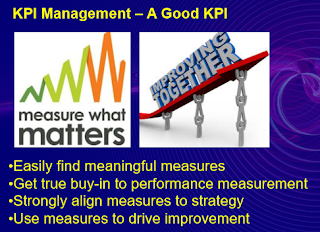We have designed Business Intelligence dashboard to help managers and CEOs to monitor their company well. However I noticed that many entrepreneurs are still not using the dashboard as much as I thought. I believe this indicate probably that the dashboard is not very helpful or entrepreneurs are still struggling with daily survival and dashboard is still too far ahead to see.
Anyway, we are going to look again into the design:
1. It must be fast - display in a few seconds. Convenient. Fast.
2. It must help the managers and CEOs to understand things. It must help CEOs to know that they are below certain target. They also indicate what to do in order to improve the situation.
3. It must have action items or suggestions that CEOs could do. The KPI is central to a good BI since we must know what is our target and where is the lacking.
Let us look at the definition of business intelligence:
The term Business Intelligence refers to the systems and processes that help to simplify and use information in an organization to enable faster and easier decision making by providing key information to the decision makers in a timely and efficient manner. Often, business intelligence is confused with the tools that simplify the process. It is necessary to understand that business intelligence goes beyond these tools, which are only the technology that streamline the process of business intelligence. In recent times, the concept of business intelligence has gained huge significance in every organization. To understand this significance, we first need to understand the benefits of business intelligence.
What are the benefits of Business Intelligence:
1. Helps align the organization towards its key objectives
We designed OfficeCentral so that data can be collected efficiently, almost instantly from various angles of business. The various modules are collection data all the time:
CRM -collection sales data, customer data, trend, sales activity
Accounting - sales, profit, cost, debtors, creditors, financial ratios
HR/Payroll - staff data, salary, claims, ratios
POS - transactions, trend
By combining the various data we can build Business Intelligence that an give the advantage to the CEOs and managers so that this small advantage will translate in much bigger business growth.
This is some of the things that we will do to improve the BI:
1. Accounting data - will be processed monthly and summary data will be kept in another table. This will speed up the various dashboards and financial ratios data.
2. KPI module will be added. The BI will be closely monitored as compared to KPI data. The KPI data iteslf is available and updated instantly.
3. Data from CRM, Accounting and HR and Payroll will be combined to generate certain indications such that CEOs have better insight. Obviously the KPI target will be central to what is important to monitor.
Wait for this new version of BI from OfficeCentral.
Anyway, we are going to look again into the design:
1. It must be fast - display in a few seconds. Convenient. Fast.
2. It must help the managers and CEOs to understand things. It must help CEOs to know that they are below certain target. They also indicate what to do in order to improve the situation.
3. It must have action items or suggestions that CEOs could do. The KPI is central to a good BI since we must know what is our target and where is the lacking.
Let us look at the definition of business intelligence:
The term Business Intelligence refers to the systems and processes that help to simplify and use information in an organization to enable faster and easier decision making by providing key information to the decision makers in a timely and efficient manner. Often, business intelligence is confused with the tools that simplify the process. It is necessary to understand that business intelligence goes beyond these tools, which are only the technology that streamline the process of business intelligence. In recent times, the concept of business intelligence has gained huge significance in every organization. To understand this significance, we first need to understand the benefits of business intelligence.
What are the benefits of Business Intelligence:
1. Helps align the organization towards its key objectives
We designed OfficeCentral so that data can be collected efficiently, almost instantly from various angles of business. The various modules are collection data all the time:
CRM -collection sales data, customer data, trend, sales activity
Accounting - sales, profit, cost, debtors, creditors, financial ratios
HR/Payroll - staff data, salary, claims, ratios
POS - transactions, trend
By combining the various data we can build Business Intelligence that an give the advantage to the CEOs and managers so that this small advantage will translate in much bigger business growth.
This is some of the things that we will do to improve the BI:
1. Accounting data - will be processed monthly and summary data will be kept in another table. This will speed up the various dashboards and financial ratios data.
2. KPI module will be added. The BI will be closely monitored as compared to KPI data. The KPI data iteslf is available and updated instantly.
3. Data from CRM, Accounting and HR and Payroll will be combined to generate certain indications such that CEOs have better insight. Obviously the KPI target will be central to what is important to monitor.
Wait for this new version of BI from OfficeCentral.


